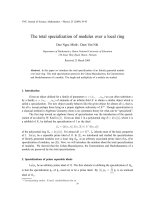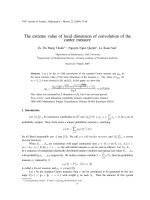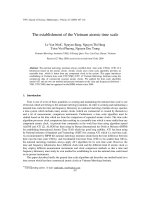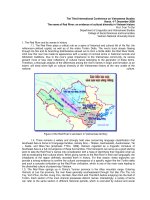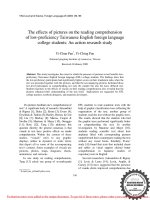Báo cáo "The dependence of the nonlinear absorption coefficient of strong electromagnetic waves caused by electrons confined in rectangular quantum wires on the temperature of the system" doc
Bạn đang xem bản rút gọn của tài liệu. Xem và tải ngay bản đầy đủ của tài liệu tại đây (71.1 KB, 6 trang )
VNU Journal of Science, Mathematics - Physics 26 (2010) 115-120
115
The dependence of the nonlinear absorption coefficient of
strong electromagnetic waves caused by electrons confined in
rectangular quantum wires on the temperature of the system
Hoang Dinh Trien*, Bui Thi Thu Giang, Nguyen Quang Bau
Faculty of Physics, Hanoi University of Science, Vietnam National University
334 Nguyen Trai, Thanh Xuan, Hanoi, Vietnam
Received 23 December 2009
Abstract. The nonlinear absorption of a strong electromagnetic wave caused by confined electrons
in cylindrical quantum wires is theoretically studied by using the quantum kinetic equation for
electrons. The problem is considered in the case electron-acoustic phonon scattering. Analytic
expressions for the dependence of the nonlinear absorption coefficient of a strong electromagnetic
wave by confined electrons in rectangular quantum wires on the temperature T are obtained. The
analytic expressions are numerically calculated and discussed for GaAs/GaAsAl rectangular
quantum wires.
Keywords: rectangular quantum wire, nonlinear absorption, electron- phonon scattering.
1. Introduction
It is well known that in one dimensional systems, the motion of electrons is restricted in two
dimensions, so that they can flow freely in one dimension. The confinement of electron in these
systems has changed the electron mobility remarkably. This has resulted in a number of new
phenomena, which concern a reduction of sample dimensions. These effects differ from those in bulk
semiconductors, for example, electron-phonon interaction and scattering rates [1, 2] and the linear and
nonlinear (dc) electrical conductivity [3, 4]. The problem of optical properties in bulk semiconductors,
as well as low dimensional systems has also been investigated [5-10]. However, in those articles, the
linear absorption of a weak electromagnetic wave has been considered in normal bulk semiconductors
[5], in two dimensional systems [6-7] and in quantum wire [8]; the nonlinear absorption of a strong
electromagnetic wave (EMW) has been considered in the normal bulk semiconductors [9], in quantum
wells [10] and in cylindrical quantum wire [11], but in rectangular quantum wire (RQW), the
nonlinear absorption of a strong EMW is still open for studying. In this paper, we use the quantum
kinetic quation for electrons to theoretically study the dependence of the nonlinear absorption
coefficient of a strong EMW by confined electrons in RQW on the temperature T of the system. The
problem is considered in two cases: electron-optical phonon scattering and electron-acoustic phonon
scattering. Numerical calculations are carried out with a specific GaAs/GaAsAl quantum wires to
______
*
Corresponding author. Tel.: +84913005279
E-mail:
H.D. Trien et al. / VNU Journal of Science, Mathematics - Physics 26 (2010) 115-120
116
show the dependence of the nonlinear absorption coefficient of a strong EMW by confined electrons
in RQW on the temperature T of the system.
2. The dependence of the nonlinear absorption coefficient of a strong EMW in a WQW on the
temperature T of the system
In our model, we consider a wire of GaAs with rectangular cross section (
LxLy
×
) and length
Lz
,
embedded in GaAlAs. The carriers (electron gas) are assumed to be confined by an infinite potential in
the (
,
xy
) plane and are free in the
z
direction in Cartesian coordinates (
,,
xyz
). The laser field
propagates along the
x
direction. In this case, the state and the electron energy spectra have the form
[12]
2
|,,=()();
ipz
z
xy
zxy
enxy
npsinsin
LL
LLL
ππ
〉
l
r
l
2
222
,
22
()=()
22
z
n
xy
p n
p
mmLL
π
ε ++
l
l
r
(1)
where
n
and
l
(
n
,
l
=1, 2, 3, ) denote the quantization of the energy spectrum in the x and y
direction,
=(0,0,)
z
pp
r
is the electron wave vector (along the wire's
z
axis),
m
is the effective mass
of electron (in this paper, we select
h
=1).
Hamiltonian of the electron-phonon system in a rectangular quantum wire in the presence of a
laser field
0
()=()
EtEsint
Ω
rr
, can be written as
,,,,,
,,
()=(())
nlnlpnlpqqq
nlpq
e
HtpAtaabb
c
εω
++
−+
∑∑
rrrrr
rr
r
r
,,,,,,,
,,,,,
()()
qnlnlnlpqnlpqq
nlnlpq
CIqaabb
++
′′′′
+−
′′
++
∑
rrrrrr
rr
r
(2)
where
e
is the electron charge, c is the light velocity,
()
At
r
=
0
()
c
Ecost
Ω
Ω
r
is the vector potential,
0
E
r
and
Ω
is the intensity and frequency of EMW,
,,
np
a
+
r
l
,,
()
np
a
r
l
is the creation (annihilation) operator of
an electron,
q
b
+
r
(
q
b
r
) is the creation (annihilation) operator of a phonon for a state having wave vector
q
r
,
q
C
r
is the electron-phonon interaction constants.
,,,
()
nlnl
Iq
′′
r
is the electron form factor, it is written
as [13]
42
,,,
4222242222
32()(1(1)())
()=
[()2()()()]
nn
xxxx
nlnl
xxxx
qLnncosqL
Iq
qLqLnnnn
π
ππ
′
+
′′
′
−−
×
′′
−++−
r
42
4222242222
32()(1(1)())
[()2()()()]
yyyy
yyyy
qLcosqL
qLqL
π
ππ
′
+
′
−−
′′
−++−
ll
ll
llll
(3)
The carrier current density
()
jt
r
and the nonlinear absorption coefficient of a strong
electromagnetic wave
α
take the form [6]
,,0
2
,,
0
8
()=(())();=()
npt
np
ee
jtpAtntjtEsint
mc
cE
π
α
χ
∞
−〈Ω〉
∑
r
l
r
l
r
r
rr
r
(4)
where
,,
()
np
nt
r
l
is electron distribution function,
t
X
〈〉
means the usual thermodynamic average of X
(
0
()
XjtEsint
≡Ω
r
r
) at moment t,
χ
∞
is the high-frequency dielectric constants.
H.D. Trien et al. / VNU Journal of Science, Mathematics - Physics 26 (2010) 115-120
117
In order to establish analytical expressions for the nonlinear absorption coefficient of a strong
EMW by confined electrons in RQW, we use the quantum kinetic equation for particle number
operator of electron
,,,,,,
()=
npnpnpt
ntaa
+
〈〉
rrr
lll
,,
,,,,
()
=[,]
np
npnpt
nt
iaaH
t
+
∂
〈〉
∂
r
l
rr
ll
(5)
From Eq.(5), using Hamiltonian in Eq.(2) and realizing calculations, we obtain quantum kinetic
equation for confined electrons in CQW. Using the first order tautology approximation method (This
approximation has been applied to a similar exercise in bulk semiconductors [9.14] and quantum
wells [10]) to solve this equation, we obtain the expression of electron distribution function
,,
()
np
nt
r
l
.
22
00
,,''
22
,,,
''
,=
,,
,,1
()=||||()()
ilt
npqkkl
nn
kl
qn
eEqeEq
ntCIJJe
mml
∞
−Ω
+
−∞
−×
ΩΩΩ
∑∑
rr
l
ll
r
l
rr
rr
,,'',,''
,,,,
'',,'',,
,,,,
(1)(1)
{
npqqnpqq
npqnpq
npqnpq
npqnpq
nNnNnNnN
kiki
εεωδεεωδ
++
++
+−−+
×−−+
−+−Ω+−−−Ω+
rrrrrr
rrrr
ll
ll
rrrr
rrrr
ll
ll
'',,'',,
,,,,
,,'',,''
,,,,
(1)(1)
}
qnpqqnpq
npqnpq
npqnpq
npqnpq
nNnNnNnN
kiki
εεωδεεωδ
−−
−−
+−−+
++
−+−Ω+−−−Ω+
rrrrrr
rrrr
ll
ll
rrrr
rrrr
ll
ll
(6)
where
,
()
qnp
Nn
rr
is the time independent component of the phonon (electron) distribution function,
()
k
Jx
is Bessel function, the quantity
δ
is infinitesimal and appears due to the assumption of an
adiabatic interaction of the electromagnetic wave. We insert the expression of
,,
()
np
nt
r
l
into the
expression of
()
jt
r
and then insert the expression of
()
jt
r
into the expression of
α
in Eq.(4). Using
properties of Bessel function and realizing calculations, we obtain the nonlinear absorption coefficient
of a strong EMW by confined electrons in RQW
2
22
'',,''
2
,,,,,
''
,=
0,,,
8
=||||[]
qqnp
nnnpq
qpk
nn
ICNnn
cE
π
α
χ
∞
+
−∞
∞
Ω
−×
∑∑∑
rrr
rr
l
lll
rr
ll
2
0
'',,
2
,,
()()[]
knpqqq
npq
eEq
kJk
m
δεεωωω
+
×−+−Ω+→−
Ω
rrrr
rr
l
l
r
(7)
where
()
x
δ
is Dirac delta function.
In the following, we study the problem with different electron-phonon scattering mechanisms. We
only consider the absorption close to its threshold because in the rest case (the absorption far away from
its threshold)
α
is very smaller. In the case, the condition
0
||k
ωε
Ω−
=
must be satisfied. We restrict
the problem to the case of absorbing a photon and consider the electron gas to be non-degenerate:
3
2
,,
**
0
,,00
3
2
0
()
=(), with =
()
np
np
b
b
ne
nnexpn
kT
VmkT
ε
π
−
r
l
r
l
(8)
where,
V
is the normalization volume,
0
n
is the electron density in RQW,
0
m
is the mass of free
electron,
b
k
is Boltzmann constant.
H.D. Trien et al. / VNU Journal of Science, Mathematics - Physics 26 (2010) 115-120
118
2.1 Electron- optical Phonon Scattering
In this case,
0
q
ωω
≡
r
is the frequency of the optical phonon in the equilibrium state. The electron-
optical phonon interaction constants can be taken as [6-8]
(
)
2222
000
||||=1/1//2
op
CCeqV
ωχχε
∞
≡−
rr
,
here V is the volume,
0
ε
is the permittivity of free space,
χ
∞
and
0
χ
are the high and low-frequency
dielectric constants, respectively. Inserting
q
C
r
into Eq.(7) and using Bessel function, Fermi-Dirac
distribution function for electron and energy spectrum of electron in RQW, we obtain the explicit
expression of
α
in RQW for the case electron-optical phonon scattering
43/2
2
0
,,0
3
,,
0
0
2()111
=()||[{()}1]
4
b
nn
nn
b
enkT
Iexp
kT
cmV
π
αω
χχ
εχ
′′
′′
∞
∞
−−Ω−×
Ω
∑
ll
ll
22
222
0
00
224
3
1
{()}[1(1)][]
282
b
bxyb
eEkT
nB
exp
kTmLLmkT
π
ωω
′′
×++++→−
Ω
l
(9)
where
2222222
0
=[()/()/]/2
xy
BnnLLmπω
′′
−+−+−Ω
ll ,
0
n
is the electron density in RQW,
b
k
is
Boltzmann constant.
2.2. Electron- acoustic Phonon Scattering
In the case,
q
ω
Ω
r
=
(
q
ω
r
is the frequency of acoustic phonons), so we let it pass. The electron-
acoustic phonon interaction constants can be taken as [6-8,10]
222
||||=/2
ac
qqs
CCqV
ξρυ
≡
rr
, here V,
ρ
,
s
υ
, and
ξ
are the volume, the density, the acoustic velocity and the deformation potential constant,
respectively. In this case, we obtain the explicit expression of
α
in RQW for the case of electron-
acoustic phonon scattering
225/2
222
2
0
''
22
23
,,,
''
,,,
2() 1
=||{()}
2
4
b
nn
bxy
s nn
menkT n
Iexp
kTmLL
cV
πξ π
α
χρυ
∞
′′
+×
Ω
∑
ll
ll
l
222
2
0
42
3() 3
[{}1]1[1(3)]
244()4
b
bbbb
eEkTDDD
exp
kTkTmDkTkT
Ω
×−++++
Ω
(10)
where
2222222
=[()/()/]
xy
DnnLLπ
′′
−+−−Ω
ll
From analytic expressions of the nonlinear absorption coefficient of a strong EMW by confined
electrons in RQWs with infinite potential (Eq.9 and Eq.10), we see that the dependence of the
nonlinear absorption coefficient of a strong electromagnetic wave by confined electrons in rectangular
quantum wires on the temperature T is complex and nonlinear. In addition, from the analytic results,
we also see that when the term in proportional to quadratic the intensity of the EMW (
2
0
E
) (in the
expressions of the nonlinear absorption coefficient of a strong EMW) tend toward zero, the nonlinear
result will turn back to a linear result.
3. Numerical results and discussions
In order to clarify the dependence of the nonlinear absorption coefficient of a strong
electromagnetic wave by confined electrons in rectangular quantum wires on the temperature T, in this
H.D. Trien et al. / VNU Journal of Science, Mathematics - Physics 26 (2010) 115-120
119
section, we numerically calculate the nonlinear absorption coefficient of a strong EMW for a
/
GaAsGaAsAl
RQW. The parameters of the CQW. The parameters used in the numerical calculations
[6,13] are =13.5
eV
ξ
,
3
=5.32
gcm
ρ
−
,
1
=5378
s
ms
υ
−
,
0
ε
=12.5,
=10.9
χ
∞
,
0
=13.1
χ
,
0
=0.066
mm
,
0
m
being the mass of free electron, =36.25
meV
ω
h ,
23
=1.380710/
b
kjK
−
× ,
233
0
=10
nm
−
,
19
=1.6021910
eC
−
× ,
34
=1.0545910.
js
−
×h .
Fig. 1. Dependence of
α
on T
(Electron- optical Phonon Scattering).
Fig. 2. Dependence of
α
on
T
(Electron- acoustic Phonon Scattering).
Figure 1 shows the dependence of the nonlinear absorption coefficient of a strong EMW on the
temperature T of the system at different values of size L
x
and L
y
of wire in the case of electron- optical
phonon scattering. It can be seen from this figure that the absorption coefficient depends strongly and
nonlinearly on the temperature T of the system. As the temperature increases the nonlinear absorption
coefficient increases until it reached the maximum value (peak) and then it decreases. At different
values of the size L
x
and L
y
of wire the temperature T of the system at which the absorption coefficient
is the maximum value has different values. For example, at
25
xy
LLnm
==
and
26
xy
LLnm
==
, the
peaks correspond to
180
TK
;
and
130
TK
;
, respectively
Figure 2 presents the dependence of the nonlinear absorption coefficient
α
on the temperature T
of the system at different values of the intensity E
0
of the external strong electromagnetic wave in the
case electron- acoustic phonon scattering. It can be seen from this figure that like the case of electron-
optical phonon scattering, the nonlinear absorption coefficient
α
has the same maximum value but
with different values of T. For example, at
6
0
2.610/
EVm
=× and
6
0
2.010/
EVm
=× , the peaks
correspond to
170
TK
;
and
190
TK
;
, respectively, this fact was not seen in bulk
semiconductors[9] as well as in quantum wells[10], but it fit the case of linear absorption [8].
4. Conclusion
In this paper, we have obtained analytical expressions for the nonlinear absorption of a strong
EMW by confined electrons in RQW for two cases of electron-optical phonon scattering and electron-
acoustic phonon scattering. It can be seen from these expressions that the dependence of the nonlinear
H.D. Trien et al. / VNU Journal of Science, Mathematics - Physics 26 (2010) 115-120
120
absorption coefficient of a strong electromagnetic wave by confined electrons in rectangular quantum
wires on the temperature T is complex and nonlinear. In addition, from the analytic results, we also see
that when the term in proportional to quadratic the intensity of the EMW (
2
0
E
) (in the expressions of
the nonlinear absorption coefficient of a strong EMW) tend toward zero, the nonlinear result will turn
back to a linear result. Numerical results obtained for a
/
GaAsGaAsAl
CQW show that
α
depends
strongly and nonlinearly on the temperature T of the system. As the temperature increases the
nonlinear absorption coefficient increases until it reached the maximum value (peak) and then it
decreases. This dependence is influenced by other parameters of the system, such as the size L
x
and L
y
of wire, the intensity E
0
of the strong electromagnetic wave. Specifically, when the intensity E
0
of the
strong electromagnetic wave (or the size L
x
and L
y
of wire) changes the temperature T of the system at
which the absorption coefficient is the maximum value has different values. , this fact was not seen in
bulk semiconductors[9] as well as in quantum wells[10], but it fit the case of linear absorption [8].
Acknowledgments. This work is completed with financial support from the Vietnam National
Foundation for Science and Technology Development (103.01.18.09).
References
[1] N. Mori, T. Ando, Phys. Rev.B, vol 40 (1989) 6175.
[2] J. Pozela, V. Juciene, Sov. Phys. Tech. Semicond, vol 29 (1995) 459.
[3] P. Vasilopoulos, M. Charbonneau, C.N. Van Vlier, Phys. Rev.B, vol 35 (1987) 1334.
[4] A. Suzuki, Phys. Rev.B, vol 45 (1992) 6731.
[5] G.M. Shmelev, L.A. Chaikovskii, N.Q. Bau, Sov. Phys. Tech. Semicond, vol 12 (1978) 1932.
[6] N.Q. Bau, T.C. Phong, J. Phys. Soc. Japan, vol 67 (1998) 3875.
[7] N.Q. Bau, N.V. Nhan, T.C. Phong, J. Korean Phys. Soc, vol 41 (2002) 149 .
[8] N.Q. Bau, L. Dinh, T.C. Phong, J. Korean Phys. Soc, vol 51 (2007) 1325.
[9] V.V. Pavlovich, E.M. Epshtein, Sov. Phys. Solid State, vol 19 (1977) 1760.
[10] N.Q. Bau , D.M. Hunh, N.B. Ngoc, J. Korean Phys. Soc, vol 54 (2009) 765.
[11] N.Q. Bau, H.D. Trien, J. Korean Phys. Soc, vol 56 (2010) 120.
[12] T.C. Phong, L. Dinh, N.Q. Bau, D.Q. Vuong, J. Korean. Phys. Soc, vol 49 (2006) 2367.
[13] R. Mickevicius, V. Mitin, Phys. Rev. B, vol 48 (1993) 17194.
[14] V.L. Malevich, E.M. Epstein, Sov. Quantum Electronic, vol 1 (1974) 1468.

